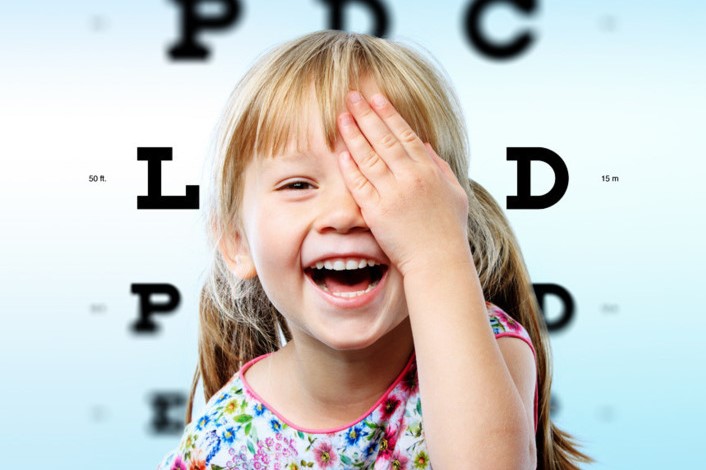
Lazy eye: how to recognise and treat amblyopia?
Amblyopia, commonly known as lazy eye, is a condition that appears as early as 3-4 years of age and involves a reduction in the visual capacity of one eye
It is a very common disorder in children, but in most cases parents are unable to recognise it, especially if it is not accompanied by obvious squinting.
Therefore, in order to diagnose the problem at an early stage and avoid permanent loss of visual capacity of the eye, it is necessary to perform an eye examination of the child and an orthoptic evaluation by the age of 3.
Lazy eye: a disorder not to be underestimated from an early age
Amblyopia or “lazy eye” is a variable degree of reduction in the visual capacity of one eye, caused by eye diseases such as congenital cataracts.
In the majority of cases it occurs in eyes that are anatomically perfectly intact and where the cause lies in refractive defects (myopia, hypermetropia, astigmatism) that are not corrected or very different between the two eyes (anisometropia) associated or not with visual misalignment (strabismus).
CHILD HEALTH: LEARN MORE ABOUT MEDICHILD BY VISITING THE STAND AT EMERGENCY EXPO
The causes of lazy eye and the difficulty of recognising amblyopia
Lazy eye is a condition that occurs from an early age.
In the first few years of life (3-4 years), the brain learns to process the information received from the eyes and, if the deficit occurs during this delicate phase, it becomes accustomed to relying only on the dominant eye, thus causing the disorder.
It can be difficult to tell if you have amblyopia, because in the early stages it does not interfere with your daily routine and good vision in the dominant eye comes in to help.
Furthermore, diagnosis is difficult because it is often children who are too young, unaware of the difficulty and therefore unable to communicate it.
For this reason it is recommended to carry out specific checks, even in the absence of signs and/or symptoms.
Diagnosis of lazy eye: the role of the ophthalmologist and orthoptist
The ophthalmologist has the task of detecting the presence and eliminating anatomical obstacles, as well as quantifying and correcting the refractive defect.
The orthoptist, on the other hand, is the professional figure in charge of visual rehabilitation, through the implementation of therapeutic programmes tailored to the severity, age and needs of the person.
His task is to assess through orthoptic evaluation
- ocular alignment
- ocular motility;
- colour perception;
- contrast sensitivity (through orthoptic assessment).
Orthoptic assessment: how it works and what it’s for
The orthoptic assessment takes between 15 and 20 minutes and includes a series of non-invasive tests specifically for the differential diagnosis of various visual impairments, strabismus and pathologies.
These investigations should be chosen according to the age and cooperation of the patient.
The main examinations concern the assessment and measurement of
- visual acuity to exclude or classify refractive defect;
- ocular motility to exclude or classify a strabismus;
- head position;
- position of the pupillary reflex;
- sense of three-dimensionality (stereopsis);
- colour sense to exclude or classify dyschromatopsia such as colour blindness;
- contrast sensitivity.
Depending on the situation, the orthoptist can decide whether it is necessary to investigate further by means of specific diagnostic tests (visual field, corneal topography and pachymetry, analysis of the fibres in the optic nerve…).
Treating lazy eye starts with visual rehabilitation
Visual rehabilitation is entrusted to the orthoptist who, after careful assessment, will decide on the most suitable treatment option for the individual.
In the case of amblyopia, rehabilitation consists of vision stimulation.
Basically, the lazy eye is “forced to work”, so that it gets used to viewing images correctly.
The most commonly used technique is occlusive therapy.
Occlusion therapy: what it is and how long it lasts
Occlusive therapy consists of covering the dominant eye with a bandage or a patch with an adhesive border for a daily period determined according to the degree of amblyopia to be corrected and the patient’s age.
Throughout the bandage time, the person should observe closely while performing an activity of their choice or set, recommended by the orthoptist.
It is only at this distance that the lazy eye is “forced to work”.
The orthoptist should re-examine the patient at regular intervals, precisely in order to assess the results of the therapy and modify them if necessary.
The duration of rehabilitation can vary from several months to several years depending on the degree of:
- severity of the disorder;
- presence of strabismus;
- cooperation of the patient;
- age of the patient at the start of therapy.
In certain cases of strabismus (refractive strabismus), rehabilitation therapy can restore the eyes to the correct visual alignment, while in others it may not be sufficient and surgery may be necessary.
Read Also:
Blepharoptosis: Getting To Know Eyelid Drooping


